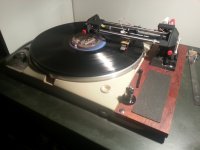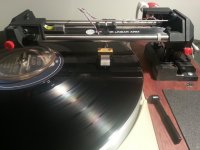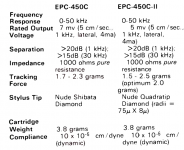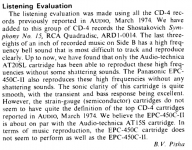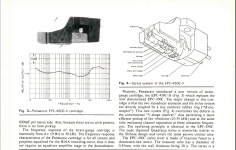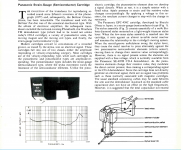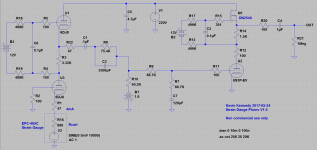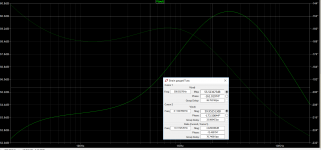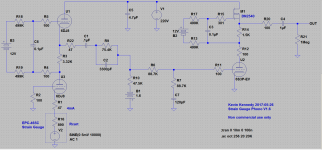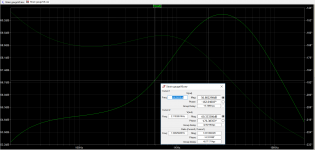I replaced the bodge of an arm with one of the ones I made from scratch, sufficient mass to allow me to use a 10gm counter weight, no spacers, nuts or putty.
When they recommend 4gms for tracking force they are not kidding. It sounds significantly better here than at 3.6gms. Both the 460C and 465C require higher tracking forces than apparently the 450/451 series which it is purported tracked OK below 3gms.
The total (not effective mass) of this arm and counterweight is about 22 gms, the cartridge adds a paltry 3.5gms to that total.
Subjectively I don't think I am quite where I want to be yet, but making progress.
I may very well need to invest in a better stylus.
When they recommend 4gms for tracking force they are not kidding. It sounds significantly better here than at 3.6gms. Both the 460C and 465C require higher tracking forces than apparently the 450/451 series which it is purported tracked OK below 3gms.
The total (not effective mass) of this arm and counterweight is about 22 gms, the cartridge adds a paltry 3.5gms to that total.
Subjectively I don't think I am quite where I want to be yet, but making progress.
I may very well need to invest in a better stylus.
Attachments
Late last night I decided to try the used conical stylus (cream colored grip) that came along
with the cartridges, to my considerable surprise it sounds pretty good. I'm currently
running at 3.5 - 3.6gms and up to 4gms is recommended.
The higher tracking forces will cause less groove deformation with a conical stylus.
Surprised, someone on VE made the reverse claim. I have not thought through the force distributions due to the differing geometries. Suspect you are probably correct.
I'm back to the Shibata and am now tracking at 4gms because regardless of stylus geometry the highs sound cleaner.
The conical seems to be much more forgiving of things like VTA and I will switch back shortly. It's sooo easy.. lol
I'm back to the Shibata and am now tracking at 4gms because regardless of stylus geometry the highs sound cleaner.
The conical seems to be much more forgiving of things like VTA and I will switch back shortly. It's sooo easy.. lol
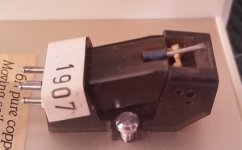
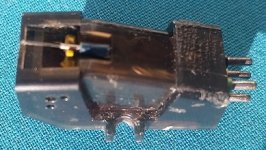
Hi Kevin, main problem with WIN is that stylus is not user replaceable. I have bought one WIN on eBay with a low mileage stylus - the seller was a DIYAudio member so I was able to bid with confidence on this fact. THe original WIN had a hollow aluminium cantilever which you can see in the photo. I also bought locally a WIN which had been re-built by Garrott Brothers. You can see that that they have cut the aluminium cantilever and inserted a new boron cantilever into the hollow aluminium tube. In USA, I assume that SoundSmith might be able to do a similar job. But probably not cheaply.Maybe you can provide some details wrt what to look for in a WIN cartridge. I know comparatively little about them, I don't even know if they have replaceable stylii.. What stylii are you using on your Panasonics?
Later WINs had a boron cantilever. I've never seen one in the flesh.
An audio colleague had possession of a WIN strain gauge amp. We pulled it apart and the circuit was a very simple affair - a non-invertiung op-amp with a gain of about 40 if memory serves me rightly. It was obviously intended to plug into a pre-amp with gain. Like you, I design all my line stages for a target output of approx 2 volts and I consider the WIN gain stage essentially worthless.
My Panasonic EPC460 came with a low mileage original quad stylus which performs well. My EPC451 came with a cheap unbranded replacement stylus, I use the original quad stylus for this cartridge - fortunately all the sylii are interchangeable for EPC450C/451/460/465.
Regards,
Last edited:
I'm back to the Shibata after another foray with the conical, the cartridge is running in an arm wand installed on one of my two Souther linear trackers.
I'd appreciate a snap shot or two of the WIN when you have a moment to post a picture. Gives me some idea of what to look for.
I'd appreciate a snap shot or two of the WIN when you have a moment to post a picture. Gives me some idea of what to look for.
Well that was quick!! I realised that I forgot to add the photos, and editied my post to include them - see my last post just above.I'm back to the Shibata after another foray with the conical, the cartridge is running in an arm wand installed on one of my two Souther linear trackers.
I'd appreciate a snap shot or two of the WIN when you have a moment to post a picture. Gives me some idea of what to look for.
Kevin, I'm not sure what you are trying to correct with your new hf pole. If you are merely trying to correct for the RIAA curve then another hf pole at 9kHz is definitely not needed, are you suggesting that the EPC465 cartridge has a rising response (ie a departure from expected response) above 2kHz?OK, I have to confess that the shelving HPF filter approach bothered me at some level. I kept thinking that this approach results in further boosting the already substantial response above 2.12kHz. Turns out in discussions with several engineer friends that this suspicion was well founded. I have come up with a minor addition that introduces a pole and zero to knock down the response a bit above 2kHz, about 3dB at 9kHz.
All of this is an approximation as noted in the previous post, but sonically seems headed in the right direction.
The danger to those following the thread is that the design will continue to evolve - mostly in the area of the EQ, and I have not got this fully down at this point. I do feel I am moving in the right direction.
My graph of RIAA curve vs perfect strain gauge response from my earlier thread is attached - this shows that ther theoretical treble boost should be 12bB, we seem to agree that the cartridge does not need this much boost, and 4 to 6dB seems like a good figure to my ears. But I am not sure why you need to reduce gain further above 9k.
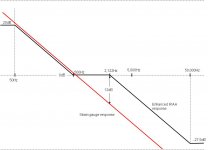
Here is a better picture of the WIN cartridge, with Garrott Brothers boron cantilever inserted into hollow aluminium tube of the original cantilever.
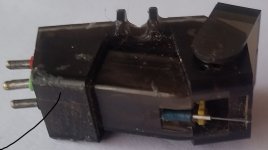
You might also notice that the terminal pins on this cart are quite tarnished (they are also loose in the cartridge body). My other WIN, with original stylus as shown in the earlier post, has nice shiny terminal pins.

You might also notice that the terminal pins on this cart are quite tarnished (they are also loose in the cartridge body). My other WIN, with original stylus as shown in the earlier post, has nice shiny terminal pins.
Last edited:
Not sure of the compliance of these SG carts. But a short linear tone arm mimics a lightweight version of a regular tonearm for high compliance cartridges to a certain degree ?
Maybe adding some mortite to the headshell might bring a better balance overall and maybe a lower tracking force as well?
Easy experiment to try.
Regards
David
Maybe adding some mortite to the headshell might bring a better balance overall and maybe a lower tracking force as well?
Easy experiment to try.
Regards
David
Kevin, I'm not sure what you are trying to correct with your new hf pole. If you are merely trying to correct for the RIAA curve then another hf pole at 9kHz is definitely not needed, are you suggesting that the EPC465 cartridge has a rising response (ie a departure from expected response) above 2kHz?
My graph of RIAA curve vs perfect strain gauge response from my earlier thread is attached - this shows that ther theoretical treble boost should be 12bB, we seem to agree that the cartridge does not need this much boost, and 4 to 6dB seems like a good figure to my ears. But I am not sure why you need to reduce gain further above 9k.
View attachment 617853
The measured responses I have seen on VE and elsewhere indicated a drop of just 6dB between 500Hz - 2122Hz, and worse that above 2122Hz the response is rising again at a roughly 3dB per octave to 10kHz - my intent in adding that pole zero pair above 2122Hz was to try and flatten things out a bit, and it does sound a bit better, and yet I may also have overshot the mark a bit as well.
Were the response to prove to be as you have graphed regardless of the 6dB vs 12dB issue that second LPF shelving filter would be unnecessary. It doesn't sound right without it though which makes me suspect there is something to my suspicion.
I am going to see whether I can get one last blast of measurements out of the old FFT hardware before it goes to the scrap pile. Hopefully I'll then be able to see where I am, rather than flying blind.. Interactions with the previous stage in simulations have a significant impact on performance. Guessing is not very productive and not much fun actually.
I now have a minor noise problem on the left channel, I suspect one of the 6DJ8s is going south. (Or removing those grid stopper resistors was ill-advised.. LOL)
This was supposed to be fun.. LOL It's not. I should just go back to listening to the Windfeld and forget about this thing, but I won't. My impression though is that it is and will remain inferior to any of the really good LOMCs, but that still leaves a rather large range of devices it can surpass with the right pre-amp. Now to find the fun again..
Not sure of the compliance of these SG carts. But a short linear tone arm mimics a lightweight version of a regular tonearm for high compliance cartridges to a certain degree ?
Maybe adding some mortite to the headshell might bring a better balance overall and maybe a lower tracking force as well?
Easy experiment to try.
Regards
David
Hi Dave,
The compliance is fairly low 8 x 10-6 dynes IIRC for this particular device. (IIRC) Yes the standard low mass Souther wands do mimic low mass standard tone arms. The one I am using I built specifically for low compliance moving coils on this arm, actually seems to be a huge improvement over the lighter arm with mortite and a small nut on the head shell in order to increase mass. The overall mass of this arm wand is about 50% higher than the wand it replaced. LF tracking seems fine.
I had a chance to dig out a JICO replacement I purchased maybe 5 years ago. The red plastic molding is slightly different than a true Panasonic. Whether due to that or assembly jig error the cantilever is off angle when snapped in...more than I would let touch my vinyl.
In other areas it seems fine, but I only have a low quality microscope and can't quite see enough detail of the actual diamond.
I was busy and I never followed up with them so I really can't judge them on this one purchase and would probably try them again when my last NOS one gives up.
All the cheap-under $100 or so I see are not Panasonic, are bonded with varying degrees of adhesive failure showing plus the red plastic moldings that I have actually seen have had variation depending on the brand and some are loose in the cartridge body. Then there is the rubber life quality doubt so in that respect a fresh build is ideal.
Another point I have noticed when looking at photos of stylus's for sale is the position of the rubber coupler? They vary in the amount of actual contact with the actual strain element depending on the exact position of them on the cantilever.
Considering all the movement of the cantilever is coupled to the strain elements through the bouncy rubber coupler and it work so well is pretty amazing. Does anyone know if the elasticity of it effects the frequency response?
In other areas it seems fine, but I only have a low quality microscope and can't quite see enough detail of the actual diamond.
I was busy and I never followed up with them so I really can't judge them on this one purchase and would probably try them again when my last NOS one gives up.
All the cheap-under $100 or so I see are not Panasonic, are bonded with varying degrees of adhesive failure showing plus the red plastic moldings that I have actually seen have had variation depending on the brand and some are loose in the cartridge body. Then there is the rubber life quality doubt so in that respect a fresh build is ideal.
Another point I have noticed when looking at photos of stylus's for sale is the position of the rubber coupler? They vary in the amount of actual contact with the actual strain element depending on the exact position of them on the cantilever.
Considering all the movement of the cantilever is coupled to the strain elements through the bouncy rubber coupler and it work so well is pretty amazing. Does anyone know if the elasticity of it effects the frequency response?
There is a review of the Panasonic 450C/450CII cartridges in the August 1974 issue of Audio..
I can't unfortunately attach the entire article because of forum attachment size limits.
I have included the most interesting snippets.
This should make my obsession with EQ pretty clear. In addition there are more recent response plots over on a thread on VE.
https://www.vinylengine.com/turntable_forum/viewtopic.php?f=19&t=28750&start=300
I can't unfortunately attach the entire article because of forum attachment size limits.
I have included the most interesting snippets.
This should make my obsession with EQ pretty clear. In addition there are more recent response plots over on a thread on VE.
https://www.vinylengine.com/turntable_forum/viewtopic.php?f=19&t=28750&start=300
Attachments
I have a new pass on the EQ, it is immediately and obviously better. Still a bit too bright which I ascribe to not having exactly the values I need. So here is what I have got at the moment..
The HF shelving filter is not optimized because I don't have the right value parts currently to do it. I need to restock some of my parts bins to my chagrin.. LOL I would increase R6 and R7 to 100K.
Edit: See post #73 for an improved design.
The HF shelving filter is not optimized because I don't have the right value parts currently to do it. I need to restock some of my parts bins to my chagrin.. LOL I would increase R6 and R7 to 100K.
Edit: See post #73 for an improved design.
Attachments
According to Peter Lederman, who makes SoundSmith strain gauge cartridges (basically a badge engineered Panasonic) you don't need any equalisationI have a new pass on the EQ, it is immediately and obviously better. Still a bit too bright which I ascribe to not having exactly the values I need. So here is what I have got at the moment..
The HF shelving filter is not optimized because I don't have the right value parts currently to do it. I need to restock some of my parts bins to my chagrin.. LOL I would increase R6 and R7 to 100K.
https://www.sound-smith.com/faq/wha...-how-does-it-work-why-no-riaa-or-phono-preamp
Here are a few snippets which are kinda funny.
"The Strain Gauge cartridge does not use or require an RIAA playback filter because it inherently plays the RIAA recording EQ curve used on the record correctly."
"If one inspects the RIAA EQ, one will discover that there are two areas that occur where a displacement type cartridge will deviate a small amount from a perfectly flat playback of the recorded RIAA groove, and therefore will not produce a perfectly flat response."
"Attempts made in the distant past to perfectly and absolutely correct Strain Gauge cartridges for any amplitude anomaly have required complex equalization circuits, which add circuitry. Adding circuitry to the signal path is strongly against our audio faith tradition. "
So there you go. Just relax and play some records
You're just playing with me... LOL I'm pretty well aware of PL's position on EQing strain gauge cartridges. I've read that article. And compared to the Windfeld the unequalized SG sounds terrible, frankly even equalized to some extent while much better, it's basically no giant killer, and not close - there just are a lot of things it doesn't do both good and bad. (I may change my mind as test hardware upgrades allow me to do some actual testing and fine tuning)
All joking aside I'm still playing around, and have not figured out how to do this correctly yet. I'm making progress, and it seems that fully correcting the response anomalies is probably not the right recipe for these cartridges; with a sample of one I am not even sure just how consistent they are.
You can see from the graphs I posted that the repackaged 450CII (essentially what all the later cartridges evolved from) has significantly different frequency response from the earlier 450C, I think this may extend to a greater/lesser extent to all later versions as well, and unit to unit variation is not something I will be able to explore given the number of cartridges on hand. I suspect they are fairly consistent from what I have read, but this depends heavily on the quality of assembly. I don't think the plastic body is such a good thing, but back in the day it was a fairly cheap cartridge used on bottom of the barrel changers and pretty much anything else that would spin.
I am hesitant to design the sort of phono stage I would for a really good LOMC because I am not convinced that the payback would be commensurate with the effort and expense involved, likewise my time has value and I have a lot of other things I could be doing. (It's why I am still playing and not shifting into a more analytical mindset) I am also crippled at the moment in the test hardware department as I am in transition to something much better for audio measurement, but it's not here yet and the old system has problems that will not be addressed before scrapping late this summer.
All joking aside I'm still playing around, and have not figured out how to do this correctly yet. I'm making progress, and it seems that fully correcting the response anomalies is probably not the right recipe for these cartridges; with a sample of one I am not even sure just how consistent they are.
You can see from the graphs I posted that the repackaged 450CII (essentially what all the later cartridges evolved from) has significantly different frequency response from the earlier 450C, I think this may extend to a greater/lesser extent to all later versions as well, and unit to unit variation is not something I will be able to explore given the number of cartridges on hand. I suspect they are fairly consistent from what I have read, but this depends heavily on the quality of assembly. I don't think the plastic body is such a good thing, but back in the day it was a fairly cheap cartridge used on bottom of the barrel changers and pretty much anything else that would spin.
I am hesitant to design the sort of phono stage I would for a really good LOMC because I am not convinced that the payback would be commensurate with the effort and expense involved, likewise my time has value and I have a lot of other things I could be doing. (It's why I am still playing and not shifting into a more analytical mindset) I am also crippled at the moment in the test hardware department as I am in transition to something much better for audio measurement, but it's not here yet and the old system has problems that will not be addressed before scrapping late this summer.
Minor update to the design which reduces the boost by about 0.7dB - perhaps more reduction is warranted midband and a bit less in the extreme highs.
Edit: See post #73 for improved design
Edit: See post #73 for improved design
Attachments
You don't have a soundcard for FR measurements?
I could bring by the QA400 from Demian, all in a good cause.
- Home
- Source & Line
- Analogue Source
- Playing With Panasonic Strain Gauge Cartridges (And A Dedicated Phono Stage)
